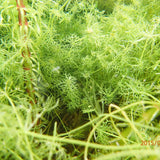Elodea Canadensis Aquatic Pond Plant - Canadian Pondweed
Elodea canadensis, also known as Canadian Waterweed or Common Elodea, is a submerged aquatic plant native to North America. It is popular among aquarium enthusiasts and serves as a beneficial addition to freshwater tanks. Here is a detailed description and care guide for Elodea canadensis:
Description:
Elodea canadensis is a fast-growing aquatic plant that typically has long, slender stems with whorls of bright green leaves. The leaves are typically arranged in groups of three and are oblong or lance-shaped, with a slightly serrated margin. The plant has a bushy appearance and can reach a height of up to 1 meter (3 feet) in optimal conditions. It forms dense clusters of vegetation, providing hiding places and grazing areas for fish and other aquatic organisms.
Care Guide:
Lighting: Elodea canadensis can adapt to a wide range of lighting conditions, but moderate to high light levels are recommended for optimal growth. If growing in an aquarium, provide at least 2-3 watts per gallon of full-spectrum light.
Water Parameters: Maintain a water temperature between 15-25°C (59-77°F). The pH level should be slightly acidic to neutral, ranging from 6.5-7.5. Elodea canadensis can tolerate a wide range of water hardness.
Substrate: It can be grown in various substrates, including sand, gravel, or aquatic soil. Ensure that the substrate is not too compact, as it can impede the growth of the plant.
Nutrient Requirements: Elodea canadensis is a nutrient-hungry plant and benefits from regular fertilization. Add a comprehensive liquid fertilizer or root tabs rich in macro and micronutrients to support its growth. Carbon dioxide (CO2) supplementation is not necessary but can promote faster growth.
Water Flow and Oxygenation: Provide moderate water flow to prevent stagnation and promote oxygenation. This can be achieved through the use of a gentle water pump or by positioning the plant near the filter outlet.
Propagation: Elodea canadensis readily propagates through stem cuttings. Simply trim healthy stems and replant them in the substrate.
Over time, new shoots will grow from the cuttings, establishing new plants.
Compatibility:
Elodea canadensis is compatible with a variety of freshwater fish and invertebrates. It provides natural cover and shade, making it suitable for both community tanks and breeding setups. It also absorbs excess nutrients, helping to maintain water quality and reduce algae growth.
Note: Elodea canadensis can grow vigorously and may require occasional pruning to maintain its shape and prevent overcrowding in the aquarium.
Overall, Elodea canadensis is a versatile and easy-to-care-for aquatic plant that adds a natural and vibrant touch to freshwater aquariums. With proper lighting, water conditions, and nutrient supplementation, it can thrive and provide numerous benefits to your aquarium ecosystem.
Selection of Plants:
Choose appropriate oxygenating plants that are suitable for the size and depth of your pond. Common oxygenating plants include Hornwort (Ceratophyllum), Anacharis (Elodea canadensis), Waterweed (Elodea densa), and Watermilfoil (Myriophyllum species).
Placement:
Place oxygenating plants in the water at a depth where their foliage is fully submerged. Distribute the plants evenly throughout the pond, ensuring they receive adequate sunlight for photosynthesis.
Water Quality:
Oxygenating plants play a crucial role in maintaining good water quality by absorbing excess nutrients, competing with algae for resources, and releasing oxygen through photosynthesis. Regularly monitor water quality parameters such as pH, ammonia, nitrite, and nitrate levels to ensure they are within suitable ranges for the plants.
Nutrient Levels:
Oxygenating plants benefit from moderate nutrient levels in the water, but excessive nutrients can lead to rapid algae growth. Avoid over-fertilization or excessive organic matter accumulation in the pond, as it can negatively impact oxygenating plants.
Pruning and Maintenance:
Regularly thin out and prune oxygenating plants to prevent overcrowding and ensure healthy growth. Remove any dead or decaying plant material promptly to maintain water quality and prevent the release of excess nutrients.
Winter Care:
Some oxygenating plants may need special attention during winter, especially in colder climates. If your pond experiences freezing temperatures, consider moving potted plants indoors or provide insulation to protect them. In milder climates, oxygenating plants may continue to grow during winter, providing oxygen and supporting the pond ecosystem.
Propagation:
Some oxygenating plants can be propagated by dividing or taking cuttings. Follow specific instructions for each plant species to propagate them successfully and maintain a healthy population in your pond.
Monitoring and Control:
Regularly observe the growth and condition of oxygenating plants to identify any signs of disease, pests, or nutrient deficiencies. If needed, control excessive growth by removing excess plant material, but be careful not to remove too much at once, as it can disturb the pond's ecological balance.
Introduction of New Plants:
Before introducing new oxygenating plants into your pond, ensure they are free from pests, diseases, or invasive species. Avoid introducing non-native species that may become invasive and harm the local ecosystem. By following these general tips and care guidelines, you can maintain healthy oxygenating plants in your pond. They will contribute to the overall oxygenation of the water, provide habitat for beneficial organisms, and promote a thriving pond ecosystem.
































